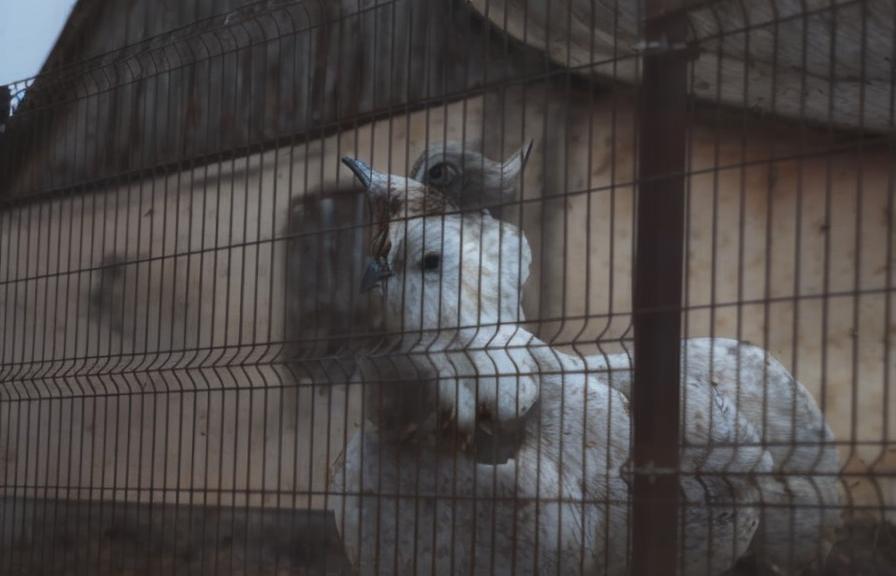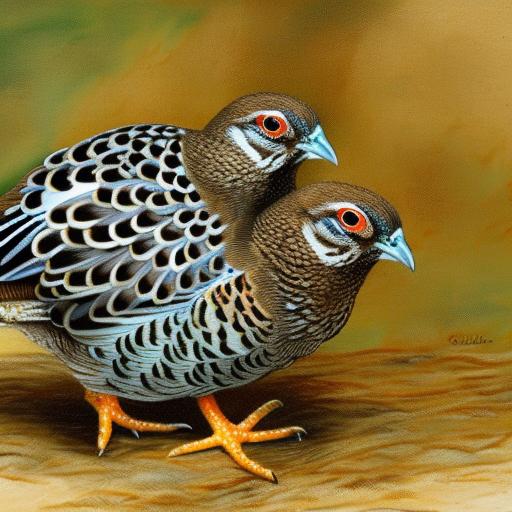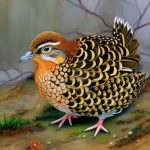Button quail, also known as Chinese painted quail, are small, ground-dwelling birds that are popular among avian enthusiasts for their unique appearance and low maintenance requirements. These birds are native to Southeast Asia and are known for their small size, colorful plumage, and interesting behaviors. Button quail are relatively easy to breed in captivity, making them a popular choice for hobbyists and breeders alike.
Breeding button quail can be a rewarding experience, but it requires careful planning and attention to detail. One of the most important factors to consider when breeding button quail is the size of the breeding cage. The size of the cage can have a significant impact on the health and well-being of the birds, as well as the success of the breeding process. In this article, we will explore the importance of cage size for button quail breeding, as well as the optimal cage size and factors to consider when choosing a cage size. We will also provide tips for setting up a breeding cage for button quail and common mistakes to avoid when choosing a cage size.
Key Takeaways
- Button quail breeding is a popular hobby due to their small size and low maintenance requirements.
- The cage size is crucial for the well-being and breeding success of button quail.
- The optimal cage size for button quail breeding is at least 12×12 inches for a pair of quail.
- Factors to consider when choosing a cage size include the number of quail, their activity level, and the presence of nesting areas.
- When setting up a breeding cage for button quail, provide ample hiding spots and nesting materials for the quail to feel secure.
Importance of Cage Size for Button Quail Breeding
The size of the breeding cage is crucial for the health and well-being of button quail. Inadequate space can lead to stress, aggression, and other behavioral issues, which can negatively impact the breeding process and the overall health of the birds. Additionally, a small cage can limit the birds’ ability to engage in natural behaviors such as foraging, dust bathing, and social interactions.
Adequate space is also important for minimizing the risk of injury and disease. In a small cage, button quail may be more prone to injuries from collisions with cage walls or other birds. Additionally, overcrowding can increase the risk of disease transmission and make it more difficult to maintain proper hygiene in the cage. Therefore, it is essential to provide button quail with a spacious and well-designed breeding cage to ensure their health and well-being.
Optimal Cage Size for Button Quail Breeding
The optimal cage size for breeding button quail depends on a variety of factors, including the number of birds being housed, the breeding setup, and the available space. As a general rule of thumb, it is recommended to provide at least 1 square foot of floor space per pair of button quail. This allows the birds to move around freely and engage in natural behaviors without feeling cramped or confined.
In addition to floor space, it is important to consider the height of the cage. Button quail are ground-dwelling birds that prefer to stay close to the ground, so a low-profile cage is ideal for providing them with a comfortable and secure environment. A cage with a height of 8-12 inches is typically sufficient for button quail, as it allows them to move around freely while still providing adequate ventilation and visibility.
It is also important to consider the layout and design of the cage when determining the optimal size. Providing ample hiding spots, perches, and areas for dust bathing can help create a stimulating and enriching environment for button quail. Additionally, it is important to consider the spacing between bars or wire mesh to prevent injury and escape.
Factors to Consider When Choosing a Cage Size
When choosing a cage size for breeding button quail, there are several factors to consider to ensure that the birds have a comfortable and safe living environment. One of the most important factors is the number of birds being housed in the cage. As mentioned earlier, it is recommended to provide at least 1 square foot of floor space per pair of button quail. If housing multiple pairs or a larger group of birds, it is important to scale up the size of the cage accordingly to accommodate their needs.
Another factor to consider is the breeding setup. If you plan to provide nesting boxes or other breeding equipment in the cage, it is important to ensure that there is enough space for these items without crowding the birds. Additionally, providing separate areas for nesting, feeding, and dust bathing can help minimize competition and stress among the birds.
The available space in your home or breeding facility is also an important consideration when choosing a cage size. It is essential to select a cage that fits comfortably in the available space and allows for easy access for cleaning and maintenance. Additionally, it is important to consider any specific environmental requirements for button quail, such as temperature and humidity levels, and ensure that the cage size allows for proper environmental control.
Tips for Setting Up a Breeding Cage for Button Quail
When setting up a breeding cage for button quail, there are several tips to keep in mind to ensure that the birds have a comfortable and stimulating environment. First and foremost, it is important to provide ample floor space for the birds to move around freely. As mentioned earlier, it is recommended to provide at least 1 square foot of floor space per pair of button quail.
In addition to floor space, it is important to provide a variety of enrichment opportunities for the birds. This can include providing hiding spots, perches, and areas for dust bathing. Adding natural materials such as sand or soil can also provide opportunities for natural behaviors such as foraging and dust bathing.
It is also important to consider the layout and design of the cage when setting up a breeding environment for button quail. Providing separate areas for nesting, feeding, and dust bathing can help minimize competition and stress among the birds. Additionally, it is important to ensure that the cage provides adequate ventilation and lighting to support the birds’ health and well-being.
Common Mistakes to Avoid When Choosing a Cage Size

When choosing a cage size for breeding button quail, there are several common mistakes that should be avoided to ensure the best possible environment for the birds. One common mistake is selecting a cage that is too small for the number of birds being housed. Inadequate space can lead to stress, aggression, and other behavioral issues that can negatively impact the breeding process and the overall health of the birds.
Another common mistake is overlooking the importance of height in addition to floor space when choosing a cage size. Button quail are ground-dwelling birds that prefer to stay close to the ground, so it is important to provide a low-profile cage that allows them to move around freely while still providing adequate ventilation and visibility.
It is also important to avoid overcrowding the cage with unnecessary equipment or decorations. While enrichment opportunities are important, it is essential to ensure that there is enough space for the birds to move around freely without feeling cramped or confined.
Ensuring the Best Environment for Button Quail Breeding
In conclusion, choosing the right cage size is crucial for ensuring the best possible environment for breeding button quail. Providing adequate floor space, considering the height of the cage, and providing enrichment opportunities are all important factors to consider when selecting a cage size. By carefully considering these factors and avoiding common mistakes, you can create a comfortable and stimulating environment for your button quail that supports their health and well-being throughout the breeding process.
When it comes to button quail breeding, the size of the cage is crucial for their well-being and successful reproduction. According to a related article on PoultryWizard, the kind of coop best for chickens also emphasizes the importance of adequate space for the birds to thrive. The article discusses how providing enough room in the coop is essential for the chickens’ health and productivity. Similarly, button quails require a spacious and well-designed breeding cage to ensure their comfort and breeding success. For more insights on coop size and design, you can check out the article “What Kind of Coop Is Best for Chickens” on PoultryWizard’s website.
FAQs
What is the ideal cage size for breeding button quail?
The ideal cage size for breeding button quail is a minimum of 24 inches long, 12 inches wide, and 12 inches high. This will provide enough space for the quail to breed and lay eggs comfortably.
Why is cage size important for breeding button quail?
Cage size is important for breeding button quail because it provides the necessary space for the quail to engage in natural breeding behaviors, such as courtship displays and nesting. A larger cage also reduces stress and aggression among the quail, which can improve breeding success.
What should be included in the breeding cage for button quail?
The breeding cage for button quail should include nesting boxes or shelters, substrate for nesting and egg laying, perches, and food and water dishes. These elements will create a suitable environment for breeding and raising offspring.
How many button quail can be housed in a breeding cage?
In a breeding cage, it is recommended to house one male button quail with two to three female button quail. This ratio will help to minimize aggression and competition among the quail and increase breeding success.
Are there any specific requirements for the breeding cage for button quail?
In addition to the size and components of the cage, it is important to provide a secure and predator-proof environment for the button quail. The cage should also be located in a quiet area with minimal disturbances to encourage breeding behavior.
Meet Walter, the feathered-friend fanatic of Florida! Nestled in the sunshine state, Walter struts through life with his feathered companions, clucking his way to happiness. With a coop that’s fancier than a five-star hotel, he’s the Don Juan of the chicken world. When he’s not teaching his hens to do the cha-cha, you’ll find him in a heated debate with his prized rooster, Sir Clucks-a-Lot. Walter’s poultry passion is no yolk; he’s the sunny-side-up guy you never knew you needed in your flock of friends!







